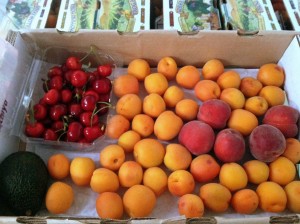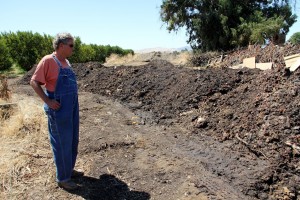THIS WEEK’S FRUIT
Rich Zee Peaches
Frog Hollow Farm, Brentwood, CA
The Rich Zee is an excellent early variety to wet the appetite for summer peaches. It is much smaller than later varieties, and is more of a water peach than a sugar peach, but a big pleaser due to its early arrival. Rich Zee has a strong fragrance, a gentle flavor, and tender juicy flesh.
Apache Apricots
Frog Hollow Farm, Brentwood, CA
The Apache is one of the newest varieties of apricots introduced to growers and was developed by the USDA Agricultural Research Service. It’s early off the tree, and like our Brooks cherries, doesn’t sacrifice any flavor or texture to beat its more popular cousins off the branch. Apache’s skin is pinkish-orange, with an orange flesh that is smooth and finely textured.
Brooks Cherries
Frog Hollow Farm, Brentwood, CA
The Brooks are our first cherries off the tree. The variety was developed at U.C. Davis in the 1980’s. Though early to arrive, Brooks don’t sacrifice taste, color or texture. They resemble a Bing with a more balanced sweetness in their dark, rich flesh.
Haas Avocado
Stehly Farms, Bonsal, CA
Creamy in texture, nutty in flavor, with a small to medium seed. The Haas avocado’s skin is easy to peel and darkens from green to purplish-black as it ripens. You can tell it is ripe by the color of the skin (dark) and if it yields to pressure.
A Note From Farmer Al
Working with compost has made me much more aware of fungi and the major role it plays, both in the environment and the ecology of life on this planet. Fungi, along with bacteria and other microbial life, are the foundation of soil, which is of course, the source of most of our food. Most of us think of bacteria and fungi as the bad guys: causing infections in people, destroying food with molds, or a nuisance in keeping the shower clean!Often believing the same, farmers are no exception. Fungi can cause tremendous losses for a farmer. Mildew is one of the biggest problems in a broad range of crops. In fruit, powdery mildew colonizes the skin of peaches, nectarines, plums and apricots. This happens early in the growth of the fruit, before the pits harden. As the pits harden and the weather warms up (mid May), the fungi die off or become inactive (dormant), but by then the damage is done. The mildew only penetrates the skin of the green fruit about two cells deep. As tiny as that seems, this leaves a scar or gray patch on the skin which develops into an ugly scar on the mature, ripe fruit. It is cosmetic only, but makes the fruit unsalable in normal retail channels (Whole Foods for example, will not take them).
To prevent this from happening, organic growers use sulfur. Spraying sulfur on the fruit creates and environment in which mildew cannot live, as the sulfur forms a protective
barrier on the skin. This year we are testing compost tea as an alternative to sulfur. The theory around this special brew is that the tea’s helpful fungi, bacteria, and protozoa will colonize the fruit’s skin and out-compete the powdery mildew for space on the fruit. It will take at least two seasons to have results that we can rely on, so we’ll keep you posted.


 Follow
Follow


